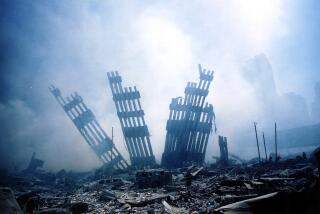Failure on a Number of Fronts
These are excerpts from the findings of the commission that investigated the Sept. 11 attacks.
Who Is the Enemy?
Who is this enemy that created an organization capable of inflicting such horrific damage on the United States? We now know that these attacks were carried out by various groups of Islamist extremists. The 9/11 attack was driven by Osama bin Laden.
In the 1980s, young Muslims from around the world went to Afghanistan to join as volunteers in a jihad (or holy struggle) against the Soviet Union. A wealthy Saudi, Bin Laden, was one of them. Following the defeat of the Soviets in the late 1980s, Bin Laden and others formed Al Qaeda to mobilize jihads elsewhere.
The history, culture and body of beliefs from which Bin Laden shapes and spreads his message are largely unknown to many Americans. Seizing on symbols of Islam’s past greatness, he promises to restore pride to people who consider themselves the victims of successive foreign masters. He uses cultural and religious allusions to the holy Koran and some of its interpreters. He appeals to people disoriented by cyclonic change as they confront modernity and globalization. His rhetoric selectively draws from multiple sources -- Islam, history and the region’s political and economic malaise.
Bin Laden also stresses grievances against the United States widely shared in the Muslim world. He inveighed against the presence of U.S. troops in Saudi Arabia, which is the home of Islam’s holiest sites, and against other U.S. policies in the Middle East.
Upon this political and ideological foundation, Bin Laden built over the course of a decade a dynamic and lethal organization. He built an infrastructure and organization in Afghanistan that could attract, train and use recruits against ever more ambitious targets. He rallied new zealots and new money with each demonstration of Al Qaeda’s capability. He had forged a close alliance with the Taliban, a regime providing sanctuary for Al Qaeda.
By Sept. 11, 2001, Al Qaeda possessed leaders able to evaluate, approve and supervise the planning and direction of a major operation; a personnel system that could recruit candidates, indoctrinate them, vet them and give them the necessary training; communications sufficient to enable planning and direction of operatives and those who would be helping them; an intelligence effort to gather required information and form assessments of enemy strengths and weaknesses; the ability to move people great distances; and the ability to raise and move the money necessary to finance an attack.
Missed Opportunities
We write with the benefit and handicap of hindsight. We are mindful of the danger of being unjust to men and women who made choices in conditions of uncertainty and in circumstances over which they often had little control.
Nonetheless, there were specific points of vulnerability in the plot and opportunities to disrupt it. Operational failures, opportunities that were not or could not be exploited by the organizations and systems of that time, included: not watch-listing future hijackers [Nawaf Alhazmi and Khalid Almihdhar], not trailing them after they traveled to Bangkok, and not informing the FBI about one future hijacker’s U.S. visa or his companion’s travel to the United States; not sharing information linking individuals in the Cole attack to Almihdhar; not taking adequate steps in time to find Almihdhar or Alhazmi in the United States; not linking the arrest of Zacarias Moussaoui, described as interested in flight training for the purpose of using an airplane in a terrorist act, to the heightened indications of attack; not discovering false statements on visa applications; not recognizing passports manipulated in a fraudulent manner; not expanding no-fly lists to include names from terrorist watch lists; not searching airline passengers identified by the computer-based CAPPS screening system; and not hardening aircraft cockpit doors or taking other measures to prepare for the possibility of suicide hijackings.
Since the plotters were flexible and resourceful, we cannot know whether any single step or series of steps would have defeated them. What we can say with confidence is that none of the measures adopted by the U.S. government from 1998 to 2001 disturbed or even delayed the progress of the Al Qaeda plot.
Failure of Imagination
The most important failure was one of imagination. We do not believe leaders understood the gravity of the threat. The terrorist danger from Bin Laden and Al Qaeda was not a major topic for policy debate among the public, the media or in the Congress. Indeed, it barely came up during the 2000 presidential campaign.
Al Qaeda’s new brand of terrorism presented challenges to U.S. governmental institutions that they were not well-designed to meet. Though top officials all told us that they understood the danger, we believe there was uncertainty among them as to whether this was just a new and especially venomous version of the ordinary terrorist threat the United States had lived with for decades, or it was indeed radically new, posing a threat beyond any yet experienced.
As late as Sept. 4, 2001, Richard Clarke, the White House staffer long responsible for counterterrorism policy coordination, asserted that the government had not yet made up its mind how to answer the question: “Is Al Qaeda a big deal?”
A week later came the answer....
Imagination is not a gift usually associated with bureaucracies. For example, before Pearl Harbor, the U.S. government had excellent intelligence that a Japanese attack was coming, especially after peace talks stalemated at the end of November 1941....
Indeed, since Al Qaeda and other groups had already used suicide vehicles, namely truck bombs, the leap to the use of other vehicles such as boats (the Cole attack) or planes is not far-fetched. Yet these scenarios were slow to work their way into the thinking of aviation security experts.
In his testimony, Clarke commented that he thought that warning about the possibility of a suicide hijacking would have been just one more speculative theory among many, hard to spot since the volume of warnings of “Al Qaeda threats and other terrorist threats was in the tens of thousands -- probably hundreds of thousands.”
Clarke told us that he was concerned about the danger posed by aircraft in the context of protecting the Atlanta Olympics of 1996, the White House complex and the 2001 G-8 summit in Genoa [Italy]. But he attributed his awareness more to Tom Clancy novels than to warnings from the intelligence community.
Unsuccessful Diplomacy
Beginning in February 1997, and through Sept. 11, 2001, the U.S. government tried to use diplomatic pressure to persuade the Taliban regime in Afghanistan to stop being a sanctuary for Al Qaeda and to expel Bin Laden to a country where he could face justice. These efforts included warnings and sanctions, but they all failed.
The U.S. government also pressed two successive Pakistani governments to demand that the Taliban cease providing a sanctuary for Bin Laden and his organization and, failing that, to cut off their support for the Taliban. Before 9/11, the United States could not find a mix of incentives and pressure that would persuade Pakistan to reconsider its fundamental relationship with the Taliban.
Saudi Arabia has been a problematic ally in combating Islamic extremism. Before 9/11, the Saudi and U.S. governments did not fully share intelligence information or develop an adequate joint effort to track and disrupt the finances of the Al Qaeda organization. On the other hand, government officials of Saudi Arabia at the highest levels worked closely with top U.S. officials in major initiatives to solve the Bin Laden problem with diplomacy.
Are We Safer?
Since 9/11, the United States and its allies have killed or captured a majority of Al Qaeda’s leadership; toppled the Taliban, which gave Al Qaeda sanctuary in Afghanistan; and severely damaged the organization. Yet terrorist attacks continue. Even as we have thwarted attacks, nearly everyone expects they will come. How can this be?
The problem is that Al Qaeda represents an ideological movement, not a finite group of people. It initiates and inspires, even if it no longer directs. In this way, it has transformed itself into a decentralized force. Bin Laden may be limited in his ability to organize major attacks from his hideouts. Yet killing or capturing him, while extremely important, would not end terror. His message of inspiration to a new generation of terrorists would continue.
Because of offensive actions against Al Qaeda since 9/11, and defensive actions to improve homeland security, we believe we are safer today. But we are not safe.
More to Read
Sign up for Essential California
The most important California stories and recommendations in your inbox every morning.
You may occasionally receive promotional content from the Los Angeles Times.










